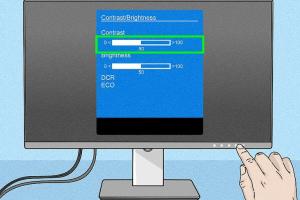Ultimate Guide on How to Calibrate Your Monitor for Perfect Display

-
Quick Links:
- Introduction
- Why Calibrate Your Monitor?
- Tools Needed for Calibration
- Manual Calibration Steps
- Software Calibration Steps
- Advanced Calibration Techniques
- Case Studies
- Expert Insights
- Common Calibration Issues
- FAQs
Introduction
In a digital world where visual content reigns supreme, ensuring that your monitor displays colors accurately is more important than ever. Whether you’re a graphic designer, photographer, or a casual user, calibrating your monitor can drastically improve your viewing experience. This guide will take you through the process of calibrating your monitor, covering everything from the basics to advanced techniques, ensuring you achieve the best display possible.
Why Calibrate Your Monitor?
Calibration is the process of adjusting the monitor to display colors accurately. Here are several reasons why monitor calibration is essential:
- Color Accuracy: Ensuring your monitor displays colors correctly is crucial for tasks that require precision, such as photo editing and graphic design.
- Improved Eye Comfort: Properly calibrated monitors reduce eye strain, allowing for longer, more comfortable viewing.
- Consistency Across Devices: Calibration helps maintain consistent colors across different devices, making your work look uniform.
- Enhanced Productivity: Accurate colors can lead to better decision-making, especially for creative professionals.
Tools Needed for Calibration
To calibrate your monitor effectively, you’ll need the following tools:
- Calibration Software: Programs like DisplayCAL, CalMAN, or Datacolor Spyder can assist in the calibration process.
- Hardware Calibration Device: Devices like the X-Rite i1 Display Pro or SpyderX Elite provide precise measurements for accurate calibration.
- Test Images: Use standardized test images to evaluate color accuracy and contrast.
Manual Calibration Steps
If you prefer a hands-on approach, follow these manual calibration steps:
1. Adjust Brightness
Start by adjusting the brightness of your monitor. Set it to a level that is comfortable for your eyes, typically around 120-140 cd/m².
2. Adjust Contrast
Increase the contrast to a level where whites appear bright but without losing detail in the brightest areas.
3. Set Color Temperature
Most monitors should be set to a color temperature of 6500K for natural color representation. This is often referred to as "D65".
4. Adjust Gamma
Gamma settings control the brightness of mid-tones. Aim for a gamma setting of around 2.2.
Software Calibration Steps
For a more precise calibration, using software can yield better results. Here’s how:
1. Install Calibration Software
Download and install your chosen calibration software. Follow the prompts for initial setup.
2. Connect Calibration Device
If using a hardware calibration device, connect it to your computer and follow the software instructions to start the calibration process.
3. Follow On-Screen Instructions
Most software will guide you through the calibration process step-by-step. Follow the on-screen instructions carefully.
4. Save Calibration Profile
After calibration is complete, save your settings as a profile that can be easily accessed for future use.
Advanced Calibration Techniques
For professionals seeking the highest accuracy, here are some advanced techniques:
- Multi-Monitor Calibration: If you use multiple monitors, calibrate them together to ensure consistency across displays.
- Regular Calibration: Make it a point to recalibrate your monitor every 1-3 months, as colors can shift over time.
- Use Reference Standards: Utilize reference standards and color charts to verify your calibration results.
Case Studies
Case studies have shown that proper monitor calibration can have significant impacts on professionals:
Example 1: Graphic Design Company
A graphic design firm reported a 30% reduction in client revisions after implementing a strict monitor calibration protocol, leading to improved client satisfaction.
Example 2: Photography Studio
A photography studio found that color accuracy improved by 50% after calibrating their monitors, which resulted in fewer print errors and better overall image quality.
Expert Insights
Experts recommend that all creative professionals invest time in monitor calibration. According to color scientist Dr. Emily Chen, “A well-calibrated monitor is essential for anyone serious about color accuracy. It’s not just about aesthetics; it’s about delivering consistent, high-quality work.”
Common Calibration Issues
Users may encounter several common issues during calibration:
- Inconsistent Results: Ensure your environment is well-lit and free from glare.
- Software Compatibility: Check that your calibration software is compatible with your monitor and operating system.
- Hardware Limitations: Some monitors may not support advanced calibration techniques due to hardware limitations.
FAQs
1. How often should I calibrate my monitor?
It’s recommended to calibrate every 1-3 months, depending on usage.
2. Can I calibrate my monitor without a hardware device?
Yes, you can manually adjust settings, but hardware devices provide more accurate results.
3. What is the best color temperature for my monitor?
6500K is generally considered optimal for most applications.
4. How do I know if my monitor is correctly calibrated?
You can use test images or color charts to check for accuracy.
5. Does monitor calibration affect gaming performance?
While it primarily affects color accuracy, proper calibration can enhance the overall gaming experience.
6. What is gamma correction?
Gamma correction adjusts the brightness of mid-tones in images.
7. Can I calibrate a TV the same way as a monitor?
Many techniques are similar, but TV calibration often involves additional settings.
8. What if my monitor won’t hold calibration settings?
Check for firmware updates or consider a factory reset.
9. Is there a difference between hardware and software calibration?
Hardware calibration uses a device for precision, while software calibration relies on manual adjustments.
10. What are common signs that my monitor needs calibration?
Faded colors, inconsistent brightness, or color shifts across devices are signs you should calibrate.
By following this guide, you’ll be well on your way to achieving a perfectly calibrated monitor, ensuring that you enjoy optimal colors and brightness for all your digital tasks.